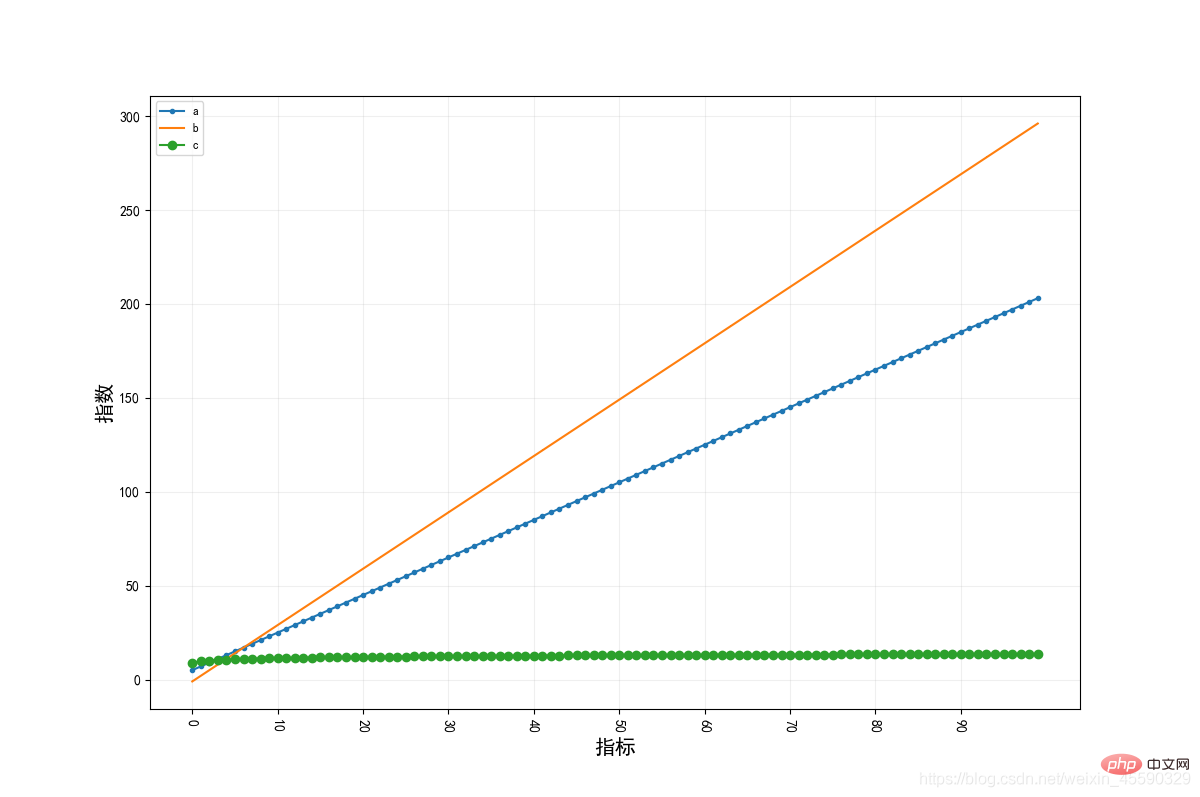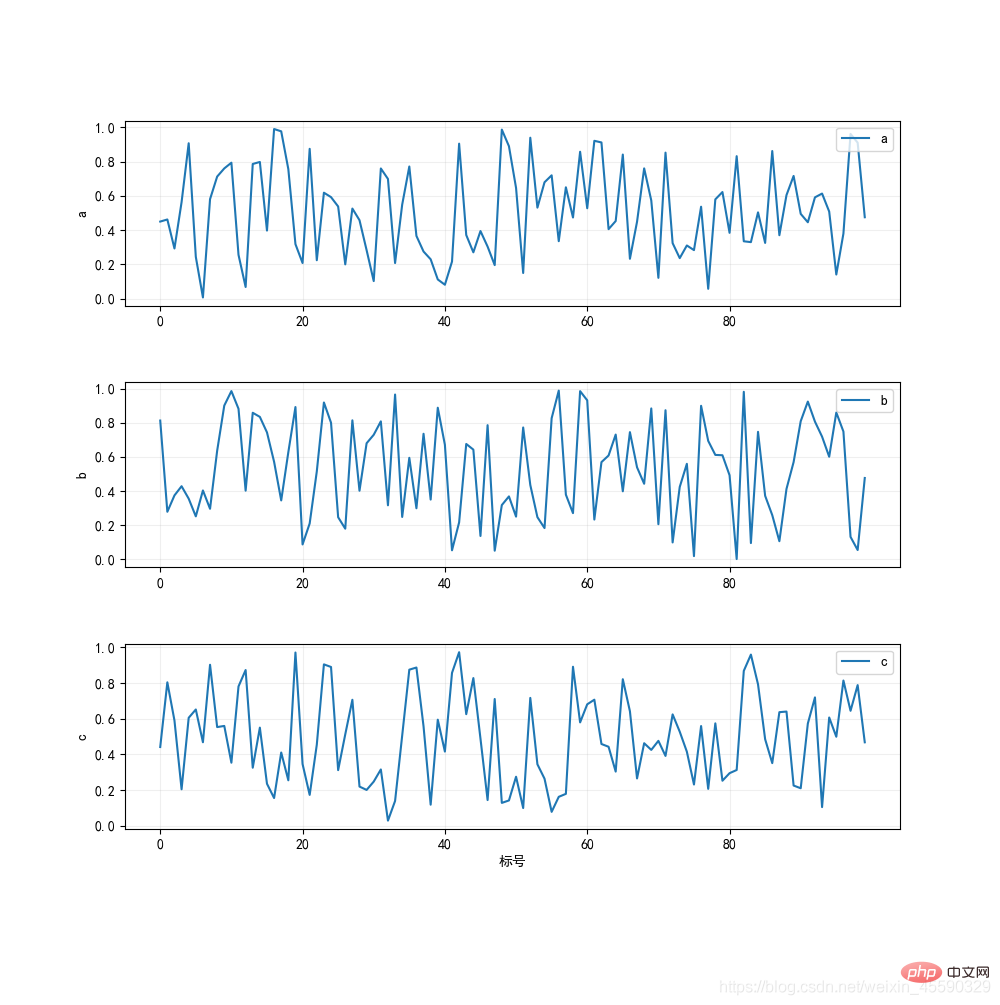 Backend Development
Backend Development
 Python Tutorial
Python Tutorial
 Introducing the common drawing functions of python's matplotlib
Introducing the common drawing functions of python's matplotlib
Introducing the common drawing functions of python's matplotlib

Free learning recommendation: python video tutorial
matplotlib has powerful drawing functions, But the sentences are trivial, and it would be too troublesome to write them sentence by sentence every time they are used. This article summarizes common drawing functions based on daily drawing experience, which can be used directly and is very convenient
import matplotlib.pyplot as pltimport pandas as pdimport numpy as np plt.rcParams['font.sans-serif']=['simhei']#用于正常显示中文标签plt.rcParams['axes.unicode_minus']=False#用于正常显示负号
1. Draw using DataFrame tables containing multiple columns of data
def plot_cols(data,xlabel=None,ylabel=None,path_file=None,marker=True,len_xticks=10,save=False):
"""
:param data:DataFrame,数据表格--行标题为横坐标,列标题为数据列
Series,序列——行标题为横坐标,name为数据列
:param xlabel: str,横坐标名称
:param ylabel: str,纵坐标名称
:param path_file: str,保存文件路径
:param marker: bool,是否为每条线添加不同的标记
:param len_xticks:int,横坐标显示的值个数
:param save: bool,是否保存图片
example:
data=pd.DataFrame(np.random.random((100,3)),index=np.arange(100),columns=['a','b','c'])
plot_cols(data,xlabel='指标',ylabel='指数')
"""
data.index=data.index.astype(str)
plt.figure(figsize=(12,8))
markers=['.',',','o','v','^','','1','2','3','4','s','p','*','h','H','+','x','D','d','|','_']#标记符号
#如果是DataFrame表格形式,则画出多列;如果是Series,则画出单列
if type(data) is pd.core.frame.DataFrame:
#是否为每条线添加不同的符号
if marker==False:
for col in data.columns:
plt.plot(data[col],marker='o',label=col)
else:
for col,marker_ in zip(data.columns,markers):
plt.plot(data[col], marker=marker_, label=col)
elif type(data) is pd.core.series.Series:
plt.plot(data, marker='o', label=data.name)
plt.legend(loc='best',fontsize='small')
xticks=np.linspace(0,len(data),(len_xticks+1)).astype(int).tolist()[:-1]#被显示的横坐标刻度值的位置
plt.xticks(data.index[xticks],rotation=270)
plt.ylabel(ylabel,fontsize=15)
plt.xlabel(xlabel,fontsize=15)
plt.grid(True,alpha=0.2)
if save==True:plt.savefig(path_file)if __name__=='__main__':
x=np.arange(1,101)
data = pd.DataFrame({'a':x*2+3,'b':x*3-4,'c':np.log(x)+9}, index=np.arange(100))
plot_cols(data, xlabel='指标', ylabel='指数')
2. Convert the DataFrame table data containing two columns into a dual-axis chart
def plot_twins(data,col1,col2,xlabel=None,ylabel1=None,ylabel2=None,len_xticks=10,figsize=(10,6),save_path=None):
"""将含有两列的DataFrame表格数据作为双轴图
:param data: DataFrame,含有两列的DataFrame表格数据
:param col1: str,左图列标题
:param col2: str,右图列标题
:param xlabel: str,横轴标题
:param ylabel1: str,左y轴标题
:param ylabel2: str,右y轴标题
:param len_xticks: int,显示的刻度个数
:param figsize: turple,图大小
:param save_path: str,图片保存路径。默认为None,不保存图片
:return:
example:
x=np.arange(0,100)
data=pd.DataFrame({'销售额(元)':3*x+np.random.random(100)*100,'增长率(%)':np.random.random(100)},index=pd.date_range('2015-01-23',periods=100,freq='D'))
plot_twins(data,col1='销售额(元)',col2='增长率(%)',xlabel=None,ylabel1='销售额(元)',ylabel2='增长率(%)')
"""
fig=plt.figure(figsize=figsize)#创建一块总画布
# 将画板分为四行四列共16个单元格,(0, 0)表示从第一行第一列即第一个单元格开始画图,将第一行的三个单元格作为一个画块作画
ax=plt.subplot2grid((1,1),(0,0),rowspan=1,colspan=1)
plt.plot(data[col1],label=col1,color='r',marker='^')
ax.legend(loc='upper right')#用于显示画布ax的图,切记用 loc= 表示位置
ax.set_ylabel(ylabel1)
xticks=np.linspace(0,len(data),(len_xticks+1)).astype(int).tolist()[:-1]#被显示的横坐标刻度值的位置
ax.set_xticks(data.index[xticks])
plt.xticks(rotation=270)
twin=ax.twinx()
plt.plot(data[col2],label=col2,color='y',marker='o')
twin.legend(loc='upper left')
twin.set_ylabel(ylabel2)
ax.set_xlabel(xlabel)
ax.grid(True,alpha=0.2)
if save_path!=None: plt.savefig(save_path)if __name__=='__main__':
x=np.arange(0,100)
data=pd.DataFrame({'销售额(元)':3*x+np.random.random(100)*100,'增长率(%)':np.random.random(100)},index=pd.date_range('2015-01-23',periods=100,freq='D'))
plot_twins(data,col1='销售额(元)',col2='增长率(%)',xlabel=None,ylabel1='销售额(元)',ylabel2='增长率(%)')
3. Convert the DataFrame Multiple columns of data in the table are drawn into multiple graphs
def plot_figs(data,xlabel=None,ylabels=None,save_path=None,len_xticks=5,length=10,width=3,intervals=1): """ 将DataFrame表格中的多列数据绘制成多个图 :param data:DataFrame,含有多列的表格 :param xlabel:str,横轴标题 :param ylabels:list,各个图的纵轴标题 :param path_save:str,图片保存路径。默认为None,不保存图片 :param len_xticks: int,显示的刻度个数 :param length:int,画板长度 :param width:int,图画宽度 :param intervals:int,图画之间间隔距离 :return: example: data=pd.DataFrame(np.random.random((100,3)),index=np.arange(100),columns=['a','b','c']) plot_figs(data,xlabel='标号',ylabels=['a','b','c']) """ cols=data.columns num_fig = len(data.columns) fig = plt.figure(figsize=(length, 4*num_fig)) # 创建一块总画布 for i in range(0,num_fig): #i=2 ax = plt.subplot2grid((num_fig*(width+intervals), 1), (i*(width+intervals), 0), rowspan=width, colspan=1) # 将画板分为四行四列共16个单元格,(0, 0)表示从第一行第一列即第一个单元格开始画图,将第一行的三个单元格作为一个画块作画 ax.plot(data[cols[i]], label=cols[i]) ax.legend(loc='upper right') # 用于显示画布ax1的图,切记用 loc= 表示位置 if ylabels!=None:ax.set_ylabel(ylabels[i]) if xlabels!=None and i==(num_fig-1):ax.set_xlabel(xlabel) xticks = np.linspace(0, len(data), (len_xticks + 1)).astype(int).tolist()[:-1] # 被显示的横坐标刻度值的位置 ax.set_xticks(data.index[xticks]) plt.grid(True,alpha=0.2) if save_path != None: plt.savefig(save_path)if __name__=='__main__': data=pd.DataFrame(np.random.random((100,3)),index=np.arange(100),columns=['a','b','c']) plot_figs(data,xlabel='标号',ylabels=['a','b','c'])

##Related free learning recommendations: python tutorial(video)
The above is the detailed content of Introducing the common drawing functions of python's matplotlib. For more information, please follow other related articles on the PHP Chinese website!

Hot AI Tools

Undresser.AI Undress
AI-powered app for creating realistic nude photos

AI Clothes Remover
Online AI tool for removing clothes from photos.

Undress AI Tool
Undress images for free

Clothoff.io
AI clothes remover

AI Hentai Generator
Generate AI Hentai for free.

Hot Article

Hot Tools

Notepad++7.3.1
Easy-to-use and free code editor

SublimeText3 Chinese version
Chinese version, very easy to use

Zend Studio 13.0.1
Powerful PHP integrated development environment

Dreamweaver CS6
Visual web development tools

SublimeText3 Mac version
God-level code editing software (SublimeText3)

Hot Topics
 1386
1386
 52
52
 PHP and Python: Code Examples and Comparison
Apr 15, 2025 am 12:07 AM
PHP and Python: Code Examples and Comparison
Apr 15, 2025 am 12:07 AM
PHP and Python have their own advantages and disadvantages, and the choice depends on project needs and personal preferences. 1.PHP is suitable for rapid development and maintenance of large-scale web applications. 2. Python dominates the field of data science and machine learning.
 Python vs. JavaScript: Community, Libraries, and Resources
Apr 15, 2025 am 12:16 AM
Python vs. JavaScript: Community, Libraries, and Resources
Apr 15, 2025 am 12:16 AM
Python and JavaScript have their own advantages and disadvantages in terms of community, libraries and resources. 1) The Python community is friendly and suitable for beginners, but the front-end development resources are not as rich as JavaScript. 2) Python is powerful in data science and machine learning libraries, while JavaScript is better in front-end development libraries and frameworks. 3) Both have rich learning resources, but Python is suitable for starting with official documents, while JavaScript is better with MDNWebDocs. The choice should be based on project needs and personal interests.
 Detailed explanation of docker principle
Apr 14, 2025 pm 11:57 PM
Detailed explanation of docker principle
Apr 14, 2025 pm 11:57 PM
Docker uses Linux kernel features to provide an efficient and isolated application running environment. Its working principle is as follows: 1. The mirror is used as a read-only template, which contains everything you need to run the application; 2. The Union File System (UnionFS) stacks multiple file systems, only storing the differences, saving space and speeding up; 3. The daemon manages the mirrors and containers, and the client uses them for interaction; 4. Namespaces and cgroups implement container isolation and resource limitations; 5. Multiple network modes support container interconnection. Only by understanding these core concepts can you better utilize Docker.
 How to run programs in terminal vscode
Apr 15, 2025 pm 06:42 PM
How to run programs in terminal vscode
Apr 15, 2025 pm 06:42 PM
In VS Code, you can run the program in the terminal through the following steps: Prepare the code and open the integrated terminal to ensure that the code directory is consistent with the terminal working directory. Select the run command according to the programming language (such as Python's python your_file_name.py) to check whether it runs successfully and resolve errors. Use the debugger to improve debugging efficiency.
 What is vscode What is vscode for?
Apr 15, 2025 pm 06:45 PM
What is vscode What is vscode for?
Apr 15, 2025 pm 06:45 PM
VS Code is the full name Visual Studio Code, which is a free and open source cross-platform code editor and development environment developed by Microsoft. It supports a wide range of programming languages and provides syntax highlighting, code automatic completion, code snippets and smart prompts to improve development efficiency. Through a rich extension ecosystem, users can add extensions to specific needs and languages, such as debuggers, code formatting tools, and Git integrations. VS Code also includes an intuitive debugger that helps quickly find and resolve bugs in your code.
 Python: Automation, Scripting, and Task Management
Apr 16, 2025 am 12:14 AM
Python: Automation, Scripting, and Task Management
Apr 16, 2025 am 12:14 AM
Python excels in automation, scripting, and task management. 1) Automation: File backup is realized through standard libraries such as os and shutil. 2) Script writing: Use the psutil library to monitor system resources. 3) Task management: Use the schedule library to schedule tasks. Python's ease of use and rich library support makes it the preferred tool in these areas.
 Can vs code run in Windows 8
Apr 15, 2025 pm 07:24 PM
Can vs code run in Windows 8
Apr 15, 2025 pm 07:24 PM
VS Code can run on Windows 8, but the experience may not be great. First make sure the system has been updated to the latest patch, then download the VS Code installation package that matches the system architecture and install it as prompted. After installation, be aware that some extensions may be incompatible with Windows 8 and need to look for alternative extensions or use newer Windows systems in a virtual machine. Install the necessary extensions to check whether they work properly. Although VS Code is feasible on Windows 8, it is recommended to upgrade to a newer Windows system for a better development experience and security.
 Can visual studio code be used in python
Apr 15, 2025 pm 08:18 PM
Can visual studio code be used in python
Apr 15, 2025 pm 08:18 PM
VS Code can be used to write Python and provides many features that make it an ideal tool for developing Python applications. It allows users to: install Python extensions to get functions such as code completion, syntax highlighting, and debugging. Use the debugger to track code step by step, find and fix errors. Integrate Git for version control. Use code formatting tools to maintain code consistency. Use the Linting tool to spot potential problems ahead of time.



